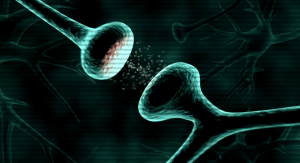Synapses
 Neurons convey information to other neurons through their synapses. Neurons can receive anywhere from 1000 to 100,000 synaptic inputs from other neurons. The average neuron makes about 1000 synaptic connections[1]. Depending on the type of synapse, the information is conveyed either chemically or electrically. What is the difference? Electrical synapses provide faster signaling than chemical ones; they can also allow synchronous firing of connected cells. Chemical synapses, on the other hand, can be exquisitely modulated and amplified as a result of learning.
Neurons convey information to other neurons through their synapses. Neurons can receive anywhere from 1000 to 100,000 synaptic inputs from other neurons. The average neuron makes about 1000 synaptic connections[1]. Depending on the type of synapse, the information is conveyed either chemically or electrically. What is the difference? Electrical synapses provide faster signaling than chemical ones; they can also allow synchronous firing of connected cells. Chemical synapses, on the other hand, can be exquisitely modulated and amplified as a result of learning.
Chemical synaptic transmission is the most common type in the mammalian brain. For chemical transmission, the synapse on the presynaptic side releases a vesicle containing a neurotransmitter to the postsynaptic side, which causes an electrical response and the movement of certain ions. Key ions involved in the synaptic potential at different times include sodium, potassium, calcium, and chloride. When the chemical binds to its receptor on the postsynaptic side, it causes a change in conductance across the postsynaptic membrane called a synaptic potential.
The postsynaptic response for a given synaptic input can either be excitatory (responding positively to a stimulus) or inhibitory (responding negatively to a stimulus).
There are seven primary neurotransmitters in humans: acetylcholine, dopamine, serotonin, norepinephrine, epinephrine, gamma-amino butyric acid (GABA), and histamine. GABA is the major inhibitory neurotransmitter in both the brain and spinal cord. These neurotransmitters vary in their postsynaptic response, as described below. They also vary in their location in the brain. Dopamine, for example, is a key neurotransmitter for the motor pathway. It is also implicated in the brain’s reward pathway.
The postsynaptic side integrates the many different synaptic inputs, depending on how close the inputs are relative to one another and the interaction of the different ionic conductances.
The strength of neurotransmitter release can be modulated by other chemicals called neuropeptides and second messengers, such as protein kinases and G protein-coupled receptors. The modulation helps to change the synapse’s strength and efficacy in response to social stimuli (in the case of many neuropeptides) and to learning.
References
[1] Kandel ER, Schwarts JH, Jessel TM (2000) Principles of Neural Science. McGraw Hill, 4th edition. 1414 pp.

